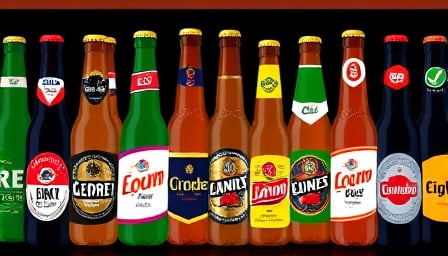Corporate News
Heineken NV: Leveraging Capital and Market Expansion Amid a Shifting Consumer Landscape
In the context of accelerating digital transformation and evolving consumer habits, Heineken NV’s recent financial maneuvers and strategic acquisitions illustrate how a global beverage leader can capitalize on demographic shifts and lifestyle trends. The Dutch brewer has secured €2 billion in new debt, earmarked for general corporate purposes and future acquisitions, while simultaneously acquiring FIFCO, a key player in the Latin American market. These moves reflect a broader industry response to a convergence of three critical forces: the blending of online and physical retail, generational spending patterns, and the continual redesign of consumer experiences.
1. Financial Flexibility as a Platform for Growth
1.1. Debt Issuance and Capital Structure
Heineken’s placement of €2 billion of notes in three tranches provides the company with a low‑cost, flexible source of capital. The structured timing of the issuance allows the firm to balance interest rates with market demand, preserving liquidity for opportunistic acquisitions or strategic investments in technology. With a market capitalization of €37.7 billion and a P/E of 20.2, the company’s valuation remains robust, suggesting that investors view the debt as a means of powering growth rather than a signal of distress.
1.2. Impact on Strategic Acquisitions
The infusion of capital aligns with Heineken’s recent purchase of FIFCO, a conglomerate that dominates the beverage market in several Latin American countries. The acquisition expands Heineken’s footprint beyond Europe, tapping into a region where consumer preferences are shifting toward premium and craft offerings. By combining debt financing with a strategic buy, Heineken demonstrates how financial engineering can unlock new revenue streams that resonate with emerging demographic segments.
2. Merging Digital and Physical Retail in a Post‑Pandemic Era
2.1. The Rise of Omnichannel Consumption
The pandemic accelerated the adoption of digital shopping, yet consumers still value the sensory experience of physical retail. Heineken’s expansion into LATAM through FIFCO offers an ideal platform for integrating e‑commerce with brick‑and‑mortar operations. For example, subscription‑based beer clubs, virtual tasting events, and mobile‑first loyalty programs can be rolled out across the newly acquired territories, creating a seamless consumer journey that spans online and offline touchpoints.
2.2. Data‑Driven Personalization
Digital transformation enables Heineken to capture granular consumer data—purchase frequency, brand preferences, and geographic insights—within its expanded distribution network. By applying machine learning algorithms to this data, the company can segment consumers more precisely, offering targeted promotions that reflect local tastes and cultural nuances. This approach not only boosts sales but also strengthens brand loyalty among younger cohorts that value authenticity and personalization.
3. Generational Spending Patterns and Lifestyle Trends
3.1. Millennials and Gen Z Priorities
Younger consumers prioritize experiences, sustainability, and ethical sourcing. Heineken’s strategy to integrate craft and functional beverages into its portfolio, particularly through FIFCO’s product lines, aligns with these preferences. Limited‑edition releases and collaborations with local artisans can generate buzz, driving traffic to both physical outlets and digital channels.
3.2. Aging Populations and Health Consciousness
Conversely, older generations—especially in European markets—are becoming more health‑aware. Regulatory pressures, such as potential tax increases on “unhealthy” beverages, may curb consumption of high‑alcohol or high‑sugar products. Heineken’s diversified product mix, which includes low‑alcohol and non‑alcoholic variants, provides a hedge against such shifts. By foregrounding these options in marketing campaigns, the company can appeal to a broader demographic while mitigating regulatory risk.
4. Navigating Regulatory and Competitive Pressures
4.1. Anticipated Taxation and Public Health Initiatives
Governments worldwide are exploring higher taxes on beverages perceived as unhealthy. For Heineken, this translates into potential margin compression, especially for high‑alcohol offerings. Proactive engagement with policymakers and investment in healthier product lines can help the company mitigate adverse impacts. Moreover, aligning corporate social responsibility initiatives with public health goals can enhance brand perception and reduce regulatory friction.
4.2. Competitive Landscape and Market Share Expansion
While the beer market remains crowded, Heineken’s acquisition of FIFCO gives it an edge in a region that is rapidly consolidating. By leveraging local distribution networks, the company can reduce logistics costs and improve time‑to‑market for new products. Simultaneously, digital tools can streamline supply chain operations, enabling real‑time inventory management and demand forecasting.
5. Forward‑Looking Market Opportunities
| Opportunity | Rationale | Expected Impact |
|---|---|---|
| Omnichannel Retail Expansion | Digital‑physical convergence | Increased customer lifetime value |
| Health‑Focused Product Portfolio | Regulatory pressure & lifestyle shift | Diversified revenue streams |
| Data‑Driven Personalization | Consumer demand for tailored experiences | Higher conversion rates |
| Sustainable Packaging Initiatives | Growing environmental consciousness | Enhanced brand reputation |
| Regional Market Penetration (LATAM) | FIFCO’s established presence | Expanded geographic diversification |
6. Conclusion
Heineken NV’s recent debt issuance and strategic acquisition illustrate a well‑calibrated response to the dynamic interplay between digital transformation, demographic evolution, and cultural movements. By strengthening its financial base, broadening its product assortment, and embedding data‑centric retail strategies, Heineken positions itself to thrive amid shifting consumer preferences and regulatory landscapes. Investors and industry observers alike should note how the company’s actions mirror a broader industry shift toward integrated, experience‑centric, and socially responsible business models—an approach that is likely to yield sustained growth and resilience in an increasingly complex market environment.
